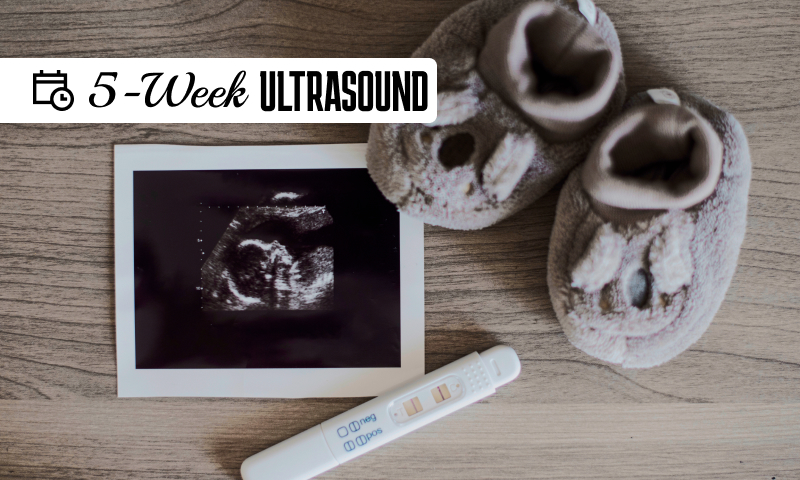The journey of pregnancy is a profound and awe-inspiring experience for expectant parents. Ultrasound technology has revolutionized prenatal care, providing an unprecedented window into the early stages of fetal development. Among the various milestones in this journey, the first ultrasound at 5 weeks holds a special significance. This pivotal moment marks the beginning of visualizing the developing embryo and sets the tone for the subsequent stages of pregnancy monitoring. In this exploration, we delve into the details of the 5 weeks pregnant ultrasound, shedding light on its purpose and significance. Also, what can parents expect during this early glimpse into their growing family?
Introduction
Pregnancy is a rollercoaster of emotions and expectations. The 5 weeks pregnant ultrasound holds a special place among the various prenatal check-ups. It’s not just a routine scan; it’s a glimpse into the beginnings of a new life. Let’s dive into the specifics and unravel the magic of this early ultrasound.
The 5 weeks pregnant ultrasound, or transvaginal ultrasound, is typically the first visual confirmation of a pregnancy. The gestational sac becomes visible at this early stage, resembling a small, fluid-filled structure within the uterus. This marks the earliest detection of the developing embryo, laying the foundation for subsequent growth and development. The procedure is safe and non-invasive, providing both healthcare providers and expectant parents with essential information about the pregnancy’s viability.
What to Expect at 5 Weeks Pregnant
Your little one is no bigger than a seed at five weeks, but the changes are profound. As the embryo implants in the uterus, your body undergoes subtle shifts, preparing for the incredible journey ahead. Understanding these changes sets the stage for the significance of the 5-week ultrasound.
Purpose of the 5-Week Ultrasound
Why bother with an ultrasound so early in the game? Beyond the excitement of seeing your baby’s first images, the 5-week ultrasound serves a crucial purpose. It confirms the pregnancy and ensures it’s developing as expected. Let’s explore the specifics of this early detection tool.
How Many Ultrasound Scans During Pregnancy
The frequency of ultrasound scans during pregnancy varies based on individual circumstances and healthcare provider preferences. Most expectant mothers undergo at least two to three ultrasound scans during low-risk pregnancies. Healthcare providers strategically schedule these scans at different stages to monitor the baby’s growth. And check for any abnormalities to ensure the overall well-being of both the mother and the developing fetus.
Preparing for the Ultrasound Appointment
Preparing for an ultrasound appointment involves a combination of practical considerations and emotional readiness. Ensure you have a full bladder before the meeting, which aids in obtaining clearer images during the ultrasound. Dress, as they may ask you to change into a hospital gown for the procedure. It’s advisable to bring your partner or a support person along to share in the experience.
Take a moment to jot down questions or concerns, as the ultrasound provides an excellent opportunity to discuss these with your healthcare provider. Approach the appointment with excitement and anticipation, understanding that this ultrasound marks the initial chapter on your journey to parenthood. Be open to the awe-inspiring moment of seeing the first glimpses of your growing baby. And remember that your healthcare team is there to guide you through every step of this miraculous process.
The Ultrasound Procedure
The pregnancy ultrasound, typically performed transvaginally, is a brief yet pivotal procedure. As the pregnant mother lies, insert a lubricated wand for a closer view of the developing gestational sac. The ultrasound technician captures real-time images, revealing the sac’s presence, confirming the pregnancy, and determining gestational age. Though the embryo may not be visible, this procedure establishes a crucial baseline for subsequent prenatal care. The experience is non-invasive, allowing for a former connection between parents and the first visual evidence of their soon-to-be family member.
Images from a 5 weeks pregnant ultrasound
Images from a 5 weeks pregnant ultrasound capture the early stages of pregnancy with simplicity and wonder. The black-and-white images typically reveal the gestational sac, resembling a small, fluid-filled structure within the uterus. The embryo may not be visible at this early point, but the sac’s presence confirms the pregnancy. The images convey a sense of anticipation and promise of a new life. While the details are minimal, the emotional impact is profound as expectant parents catch their first glimpse of the tiny space where the miraculous journey of fetal development begins. And fostering a connection to the early stages of their growing family.
Common Concerns and Questions
At 5 weeks pregnant ultrasound, common concerns revolve around the limited visibility during ultrasound. Expectant parents may wonder about the absence of a clear fetal image, as the focus is on confirming the gestational sac. Questions about the baby’s development may arise, and the uncertainty of not seeing a heartbeat is a common worry. It’s natural to seek reassurance regarding the overall health of the pregnancy. Healthcare providers are well-equipped to address these concerns, emphasizing that the 5 weeks pregnant ultrasound sets the groundwork for subsequent scans. Open communication with the healthcare team helps ease anxieties and ensures a comprehensive understanding of the early stages of pregnancy.
Also Read : Early Fetal Echocardiography
Factors Affecting Ultrasound Accuracy
Several factors can influence the accuracy of an ultrasound. First, the timing of the ultrasound is crucial, as a too-early scan might not capture the details. The equipment’s quality and the ultrasound technician’s expertise play vital roles, affecting the clarity of images. Variations in individual anatomy and differences in fetal development can affect the accuracy of gestational age determination. In irregular menstrual cycles, pinpointing the exact conception date becomes challenging. It’s essential to consider these factors when interpreting the results, and healthcare providers take them into account when assessing the overall accuracy of the ultrasound.
Benefits and Reassurance
Beyond the medical insights, the 5-week ultrasound offers emotional reassurance to expectant parents. Witnessing the first glimpses of your baby fosters a unique bond and provides a sense of connection that transcends the physical aspects of pregnancy.
Medical Insights from the Ultrasound
A 5 weeks pregnant ultrasound offers crucial medical insights despite its early stage. By confirming a gestational sac, healthcare providers establish the pregnancy’s viability and determine gestational age. While the embryo may not be visible, this initial scan aids in identifying potential complications, such as ectopic pregnancies or miscarriages. The information gleaned informs the development of a comprehensive prenatal care plan, ensuring timely intervention if needed. Medical professionals use these early insights to provide personalized care. And laying the foundation for a healthy pregnancy journey and enhancing the overall well-being of the expectant mother and the developing fetus.
The Emotional Journey
Pregnancy is not just a physical experience—it’s an emotional journey. Seeing your tiny embryo on the ultrasound screen can elicit a spectrum of feelings. Though the ultrasound reveals only the gestational sac, it sparks a profound connection to the burgeoning life within. Expectant parents experience the early stirrings of parenthood, fostering a sense of wonder and attachment to their growing family.

Tips for a Healthy Pregnancy
Beyond the 5 weeks pregnant ultrasound, maintaining a healthy pregnancy is paramount. Maintaining a healthy pregnancy involves prioritizing both physical and emotional well-being. Attend regular prenatal check-ups, following your healthcare provider’s advice. Consume a balanced diet rich in nutrients, emphasizing fruits, vegetables, and whole grains. Stay hydrated and engage in regular, moderate exercise tailored to your fitness level. Ensure sufficient rest and manage stress through relaxation techniques. Avoid harmful substances like tobacco and alcohol. Take prenatal vitamins, including folic acid. Educate yourself about pregnancy, childbirth, and postpartum care. Foster a strong support system and communicate with your healthcare team. Embracing these tips sets the foundation for a healthy and positive pregnancy experience.
Conclusion
The 5 weeks pregnant ultrasound is not just a medical procedure; it’s a profound moment in your pregnancy journey. From confirming the existence of new life to providing insights into your baby’s early development, this scan marks the beginning of a remarkable chapter.
FAQs
Is a 5-week ultrasound necessary?
While not mandatory, a 5-week ultrasound provides early confirmation of a viable pregnancy and offers reassurance.
Can I see the heartbeat in 5 weeks?
Detecting a heartbeat at 5 weeks can be challenging, but advancements in ultrasound technology enhance the chances.
What if the ultrasound reveals concerns?
Early detection allows for prompt medical intervention if they identify any concerns.
How long does a 5-week ultrasound take?
The procedure is quick, lasting around 15-20 minutes.

